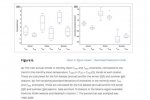You may think that, but you would be wrong. The
paper itself explicitly notes that:
The global decrease in the DTR during the latter half of the 20th century has been documented in the literature (Karl et al., 1984). Later, this distinct pattern was discovered in both global and regional temperature records (Karl et al., 1993). However, there has been some degree of temporal variation in the rate of change of the DTR, with some evidence of a slowing or even reversal of the negative trend in recent decades (Hartmann et al., 2013).
From Hartmann et al 2013 (IPCC
AR5 WG1 Ch. 2):
No dedicated global analysis of DTR has been undertaken subsequent to Vose et al. (2005a), although global behaviour has been discussed in two broader ranging analyses. Rohde et al. (2012) and Wild et al. (2007) note an apparent reversal since the mid-1980s; with DTR subsequently increasing. This decline and subsequent increase in DTR over global land surfaces is qualitatively consistent with the dimming and subsequent brightening noted in Section 2.3.3.1.
Vose et al 2005 is also directly cited in Table 1 of the Davy paper; showing a -0.07C/decade trend in DTR from 1950-2004 (in case you're wondering that's a
1.43 to 1 ratio from even marginally newer data, again obviously a far cry from your claim that it's still 3 to 1), and a zero trend in DTR from 1979-2004 (or more precisely, a
1.03 to 1 ratio).
ftp://ftp.ncdc.noaa.gov/pub/data/papers/200686amsp4.1rvfree.pdf
Both maximum and minimum temperature increases from 1979-2004 whereas the DTR is basically trendless. The maximum and minimum temperature trends are nearly identical (0.287 versus 0.295°C dec-1), and both are comparable to the mean temperature trend over global land areas for the period (0.296 °C dec-1) as derived from the Global Historical Climatology Network database (J. Lawrimore, pers. comm., 2005). Given the similarity between maximum and minimum temperature, the trend in the DTR (-0.001 °C dec-1) is not statistically significant at the 5% level.
Less than three weeks ago you personally referenced a paper which itself shows a
1.29 to 1 ratio of Tmin to Tmax change (1960-2009) and cites two other sources suggesting even smaller ratios since 1979. I've pointed this out myself twice now, and added yet another paper confirming that fact. But you're just going to go ahead and stick with your claim that there is still a 3 to 1 ratio of night to daytime warming :roll:
Guess Threegoofs was wrong that it would take you a month to 'forget' - you'll just flat out refuse to accept the evidence which you yourself presented.


